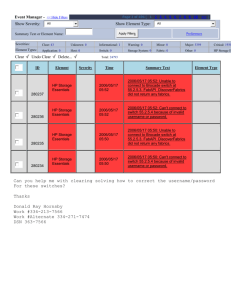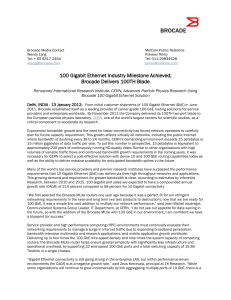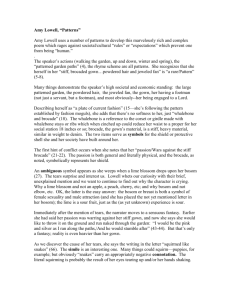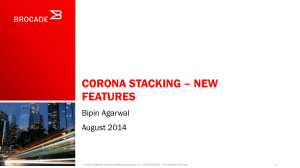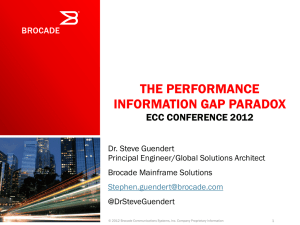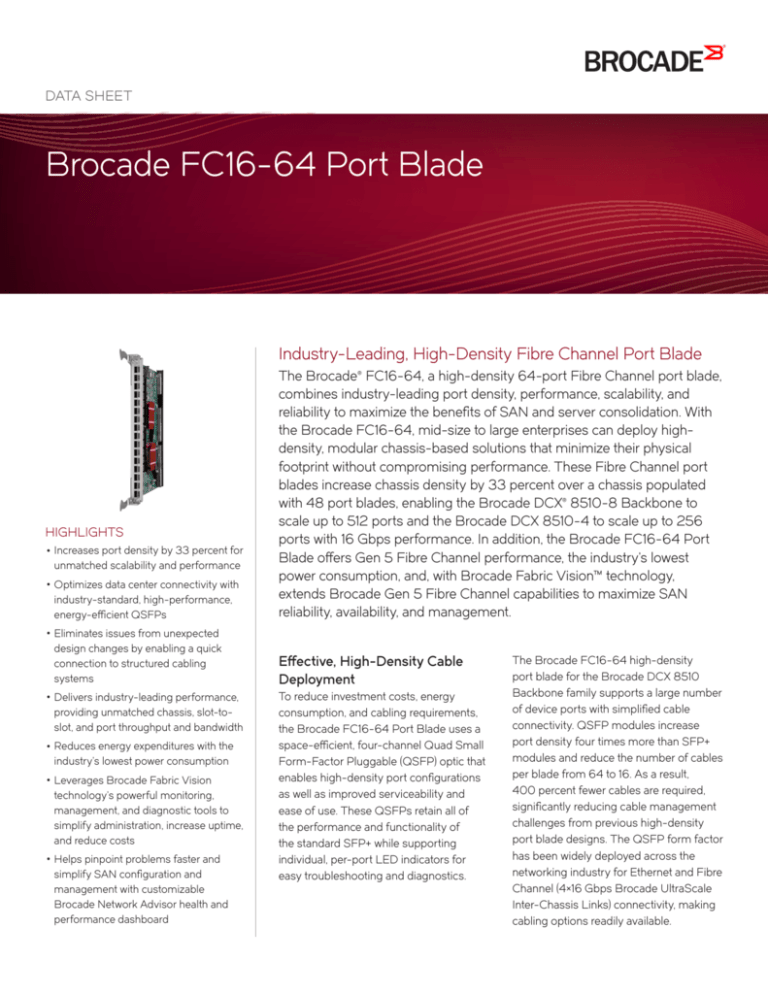
DATA SHEET
Brocade FC16-64 Port Blade
Industry-Leading, High-Density Fibre Channel Port Blade
industry-standard, high-performance,
energy-efficient QSFPs
The Brocade® FC16-64, a high-density 64-port Fibre Channel port blade,
combines industry-leading port density, performance, scalability, and
reliability to maximize the benefits of SAN and server consolidation. With
the Brocade FC16-64, mid-size to large enterprises can deploy highdensity, modular chassis-based solutions that minimize their physical
footprint without compromising performance. These Fibre Channel port
blades increase chassis density by 33 percent over a chassis populated
with 48 port blades, enabling the Brocade DCX® 8510-8 Backbone to
scale up to 512 ports and the Brocade DCX 8510-4 to scale up to 256
ports with 16 Gbps performance. In addition, the Brocade FC16-64 Port
Blade offers Gen 5 Fibre Channel performance, the industry’s lowest
power consumption, and, with Brocade Fabric Vision™ technology,
extends Brocade Gen 5 Fibre Channel capabilities to maximize SAN
reliability, availability, and management.
design changes by enabling a quick
connection to structured cabling
systems
Effective, High-Density Cable
Deployment
HIGHLIGHTS
••Increases port density by 33 percent for
unmatched scalability and performance
••Optimizes data center connectivity with
••Eliminates issues from unexpected
••Delivers industry-leading performance,
providing unmatched chassis, slot-toslot, and port throughput and bandwidth
••Reduces energy expenditures with the
industry’s lowest power consumption
••Leverages Brocade Fabric Vision
technology’s powerful monitoring,
management, and diagnostic tools to
simplify administration, increase uptime,
and reduce costs
••Helps pinpoint problems faster and
simplify SAN configuration and
management with customizable
Brocade Network Advisor health and
performance dashboard
To reduce investment costs, energy
consumption, and cabling requirements,
the Brocade FC16-64 Port Blade uses a
space-efficient, four-channel Quad Small
Form-Factor Pluggable (QSFP) optic that
enables high-density port configurations
as well as improved serviceability and
ease of use. These QSFPs retain all of
the performance and functionality of
the standard SFP+ while supporting
individual, per-port LED indicators for
easy troubleshooting and diagnostics.
The Brocade FC16-64 high-density
port blade for the Brocade DCX 8510
Backbone family supports a large number
of device ports with simplified cable
connectivity. QSFP modules increase
port density four times more than SFP+
modules and reduce the number of cables
per blade from 64 to 16. As a result,
400 percent fewer cables are required,
significantly reducing cable management
challenges from previous high-density
port blade designs. The QSFP form factor
has been widely deployed across the
networking industry for Ethernet and Fibre
Channel (4×16 Gbps Brocade UltraScale
Inter-Chassis Links) connectivity, making
cabling options readily available.
The Brocade FC16-64 has 16 QSFP
ports with each physical port interface
logically configured as a 4×16 Gbps
Fibre Channel port that complies with
14.025 Gbps Fibre Channel specifications,
and maintains backward compatibility
support for two previous generations of
Fibre Channel specifications—8.5 Gbps
and 4.25 Gbps. By using high-density
and low-power QSFPs for connectivity,
the Brocade FC16-64 Port Blade enables
consolidation of physical ports and a
75 percent reduction in cables, which
simplifies cable management and eases
scalability for greater business agility.
Lowest Power Consumption
Brocade 4×16 Gbps SWL Fibre Channelcompliant QSFP optical transceivers are
hot-swappable, low-voltage (3.3 V), digital
diagnostic-capable optical transceivers
that comply with the QSFP MSA
mechanical specification (SFF-8436).
QSFP optical transceivers provide the
Brocade FC16-64 with state-of-the-art
high density and 285 percent less power
consumption than four standard SFPs
(1.4 W vs. 4 W), the lowest power draw
of any Fibre Channel switching blade. In
fact, a Brocade DCX 8510 fully populated
with eight Brocade FC16-64 Port Blades
not only offers the highest port density,
but also draws only 1,902 watts (0.19 W/
Gbps). The closest competitive product
requires over 40 percent more energy to
power 25 percent fewer ports. Through
the use of energy-efficient QSFPs,
Brocade has enabled IT organizations
to achieve new levels of infrastructure
consolidation while reducing overall
power consumption.
Optimized Data Center
Connectivity
The Brocade FC16-64 uses QSFPs
to facilitate best practices in structured
cabling design. Using standard cables,
connections can start at the switch
and terminate at the central cross
connect, where all administration can
be performed. This helps reduce overall
costs and installation time, and increases
flexibility for future scalability. Moreover,
proper fiber connectivity design results
in an end-to-end solution that is
easier to maintain—helping to improve
the availability of data center fabrics
supporting mission-critical applications.
Simplified Management and
Robust Network Analytics
Brocade Fabric Vision technology
provides a breakthrough hardware and
software solution that helps simplify
monitoring, maximize network availability,
and dramatically reduce costs. Featuring
innovative monitoring, management,
and diagnostic capabilities, Fabric Vision
technology enables administrators to
avoid problems before they impact
operations, helping their organizations
meet Service Level Agreements (SLAs).
The Brocade FC16-64 Port Blade
supports the following Brocade Fabric
Vision technology features:
••Monitoring and Alerting Policy Suite
(MAPS): Provides a pre-built, policybased threshold monitoring and alerting
tool that proactively monitors storage
extension network health based on a
comprehensive set of metrics per circuit.
Administrators can configure multiple
fabrics at one time using pre-defined
or customized rules and policies for
specific ports or switch elements.
••Fabric Performance Impact (FPI)
Monitoring: Uses pre-defined
thresholds and alerts in conjunction
with MAPS to automatically detect and
alert administrators to severe levels
of latency, and identifies slow drain
devices that might impact the network.
This feature uses advanced monitoring
capabilities and intuitive MAPS
dashboard reporting to indicate various
latency severity levels, pinpointing
exactly which devices are causing or are
impacted by a bottlenecked port.
••Dashboards: Provides integrated
dashboards that display an overall SAN
health view, along with details on out-ofrange conditions, to help administrators
easily identify trends and quickly
pinpoint issues occurring on a switch or
in a fabric.
••Brocade ClearLink Diagnostics:
Ensures optical and signal integrity for
Gen 5 Fibre Channel optics and cables,
simplifying deployment and support of
high-performance fabrics.
••Flow Vision: Enables administrators to
identify, monitor, and analyze specific
application flows in order to simplify
troubleshooting, maximize performance,
avoid congestion, and optimize
resources. Flow Vision includes:
-- Flow Monitor: Provides
comprehensive visibility into flows
across a storage extension network,
including the ability to automatically
learn flows and non-disruptively
monitor flow performance.
Administrators can monitor all
flows from a specific storage device
that is writing to or reading from a
destination storage device or LUNs,
or across a storage extension network.
Additionally, they can perform LUNlevel monitoring of specific frame
types to identify resource contention
or congestion that is impacting
application performance.
••Credit Loss Recovery: Helps overcome
performance degradation and
congestion due to buffer credit loss.
Brocade Network Advisor
Brocade Network Advisor simplifies
Gen 5 Fibre Channel management
and helps users proactively diagnose
and resolve issues to maximize uptime,
increase operational efficiency, and
reduce costs. The wizard-driven interface
dramatically reduces deployment and
configuration times by allowing fabrics,
switches, and ports to be managed
as groups. Customizable dashboards
graphically display performance and
health indicators out of the box, including
all data captured using Brocade Fabric
Vision technology. To accelerate
troubleshooting, administrators can use
dashboard playback to quickly review
past events and identify problems in the
fabric. In addition, dashboards and reports
can be configured to show only the most
relevant data, enabling administrators to
more efficiently prioritize their actions and
maintain network performance.
Brocade Global Services
Brocade Global Services has the
expertise to help organizations build
scalable, efficient cloud infrastructures.
Leveraging 15 years of expertise in
storage, networking, and virtualization,
Brocade Global Services delivers worldclass professional services, technical
support, network monitoring services,
and education, enabling organizations
to maximize their Brocade investments,
accelerate new technology deployments,
and optimize the performance of
networking infrastructures.
Affordable Acquisition Options
Brocade Capital Solutions helps
organizations easily address their IT
requirements by offering flexible network
acquisition and support alternatives.
Organizations can select from purchase,
lease, Brocade Network Subscription,
and Brocade Subscription Plus options to
align network acquisition with their unique
capital requirements and risk profiles.
To learn more, visit www.Brocade.com/
Capital.
Maximizing Investments
To help optimize technology investments,
Brocade and its partners offer complete
solutions that include professional
services, technical support, and education.
For more information, contact a Brocade
sales partner or visit www.brocade.com.
Brocade FC16-64 Specifications
System Architecture
Fibre Channel ports
16 QSFP ports (64 total ports); E_Ports, F_Ports, M_Ports, EX_Ports, and FL_Ports
Scalability
Full fabric architecture with 239 switches maximum
Certified maximum
6,000 active nodes; 56 switches, 19 hops in Brocade Fabric OS® fabrics; 31 switches, larger fabrics certified as
required
Fibre Channel performance
Fibre Channel: 4.25 Gbps line speed, full duplex; 8.5 Gbps line speed, full duplex; 14.025 Gbps line speed, full duplex;
auto-sensing of 4, 8, and 16 Gbps port speeds
ISL trunking
Frame-based trunking with up to eight 16 Gbps ports per ISL trunk; up to 128 Gbps per ISL trunk
Exchange-based load balancing across ISLs with DPS included in Brocade Fabric OS
Fibre Channel aggregate
bandwidth
512 Gbps (data rate)
Switch latency
Locally switched port latency is 700 ns; blade-to-blade latency is 2.1 µsec; encryption/compression is 5.5 µsec per
node; Forward Error Correction (FEC) adds 400 ns between E_Ports (enabled by default)
Maximum frame size
2,112-byte payload
Frame buffers
8,192 per 64-port blades, dynamically allocated
Classes of service
Class 2, Class 3, Class F (inter-switch frames)
Fibre Channel port types
E_Port, EX_Port, F_Port, M_Port (Mirror Port), and D_Port (limited ClearLink Diagnostic port capabilities); optional
port type control
Cables supported
MTP/MPO to LC break-out cables and MTP/MPO to MTP/MPO standard cables
Data traffic types
Fabric switches supporting unicast
Media types
Brocade hot-pluggable QSFP connector; 4×16 Gbps SWL, MPO 1×12 ribbon cable connector (66 m OM3, 100 m
OM4; Brocade FC16-64 QSFPs support only 4/8/16 Gbps [not 2 Gbps or 10 Gbps])
3
Brocade FC16-64 Specifications (continued)
Fabric services
Brocade Fabric Vision technology; Monitoring and Alerting Policy Suite (MAPS); Flow Vision; Brocade Adaptive
Networking (Ingress Rate Limiting, Traffic Isolation, QoS); Fabric Performance Impact (FPI) Monitoring; Slow Drain
Device Quarantine (SDDQ); Brocade Advanced Zoning (default zoning, port/WWN zoning, broadcast zoning, peer
zoning, target driven zoning); Dynamic Fabric Provisioning (DFP); Dynamic Path Selection (DPS); Brocade Extended
Fabrics; Enhanced BB Credit Recovery; FDMI; Frame Redirection; Frame-based Trunking; FSPF; Integrated Routing;
IPoFC; Brocade ISL Trunking; Management Server; NPIV; Time Server; Registered State Change Notification (RSCN);
Reliable Commit Service (RCS); Simple Name Server (SNS); Virtual Fabrics (Logical Switch, Logical Fabric); Read
Diagnostics Parameter (RDP)
Management
Supported management
software
HTTP, SNMP v1/v3 (FE MIB, FC Management MIB), SSH; Auditing, Syslog; Brocade Advanced Web Tools, Brocade
Network Advisor SAN Enterprise or Brocade Network Advisor SAN Professional Plus; Command Line Interface (CLI);
SMI-S compliant; Administrative Domains; trial licenses for add-on capabilities
Security
AES-GCM-256 encryption on ISLs; DH-CHAP (between switches and end devices), FCAP switch authentication;
FIPS 140-2 L2-compliant, HTTPS, IPsec, IP filtering, LDAP with IPv6, OpenLDAP, Port Binding, RADIUS, userdefined Role-Based Access Control (RBAC), Secure Copy (SCP), Secure RPC, SFTP, SSH v2, SSL, Switch Binding,
TACACS+, Trusted Switch
Diagnostics
Built-in flow generator, ClearLink cable diagnostics (no support for electrical/optical loopback), link traffic/latency/
distance; POST and embedded online/offline diagnostics, including environmental monitoring, FCping and Pathinfo
(FC traceroute), flow mirroring, frame viewer, non-disruptive daemon restart, port mirroring, optics health monitoring,
power monitoring (16 Gbps blades-only), RAStrace logging, and Rolling Reboot Detection (RRD)
Mechanical
Size
Width: 3.6 cm (1.4 in.)
Height: 42.1 cm (16.6 in.)
Depth: 29.9 cm (11.8 in.)
Occupies one slot in a Brocade DCX 8510 Backbone family chassis
System weight
3.56 kg (7.85 lb) without QSFP
Environmental
Temperature
Operating: 0°C to 40°C (32°F to 104°F)
Non-operating: −25°C to 70°C (−13°F to 158°F)
Humidity
Operating: 10% to 85% non-condensing
Non-operating: 10% to 90% non-condensing
Altitude
Operating: Up to 3,000 m (9,842 ft)
Storage: Up to 12 km (39,370 ft)
Shock
Operating: 20 g, 6 ms half-sine
Non-operating: 33 g, 11 ms, half-sine, 3/eg axis
Vibration
Operating: 0.5 g sine, 0.4 grms random, 5 to 500 Hz
Non-operating: 2.0 g sine, 1.1 grms random, 5 to 500 Hz
Power
Maximum power
Corporate Headquarters
San Jose, CA USA
T: +1-408-333-8000
info@brocade.com
118 watts when fully populated with 16 standard SWL QSFP
134 watts maximum power consumption
European Headquarters
Geneva, Switzerland
T: +41-22-799-56-40
emea-info@brocade.com
Asia Pacific Headquarters
Singapore
T: +65-6538-4700
apac-info@brocade.com
© 2015 Brocade Communications Systems, Inc. All Rights Reserved. 09/15 GA-DS-2027-00
ADX, Brocade, Brocade Assurance, the B-wing symbol, DCX, Fabric OS, HyperEdge, ICX, MLX, MyBrocade, OpenScript,
The Effortless Network, VCS, VDX, Vplane, and Vyatta are registered trademarks, and Fabric Vision and vADX are trademarks
of Brocade Communications Systems, Inc., in the United States and/or in other countries. Other brands, products, or service
names mentioned may be trademarks of others.
Notice: This document is for informational purposes only and does not set forth any warranty, expressed or implied, concerning any
equipment, equipment features, or service offered or to be offered by Brocade. Brocade reserves the right to make changes to this
document at any time, without notice, and assumes no responsibility for its use. This information document describes features that
may not be currently available. Contact a Brocade sales office for information on feature and product availability. Export of technical
data contained in this document may require an export license from the United States government.

